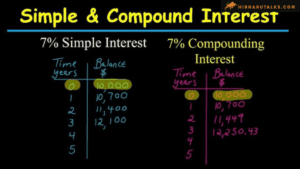
Cryptocurrency and Compound Interest: Exploring Modern Strategies for Wealth Growth
Contents
- 1 Compound Interest
- 1.1 Cryptocurrency and Compound Interest: Exploring Modern Strategies for Wealth Growth
- 1.1.1 Understanding Compound Interest in Cryptocurrency
- 1.1.2 Modern Strategies for Compounding Cryptocurrency
- 1.1.3 Risks of Compounding in Cryptocurrency
- 1.1.4 Choosing the Right Compound Interest Strategy for Crypto
- 1.1.5 Conclusion
- 1.1.6 FAQs:
- 1.1.6.1 1.What is compound interest in cryptocurrency?
- 1.1.6.2 2.Can I earn compound interest by staking crypto?
- 1.1.6.3 3.What is yield farming in crypto?
- 1.1.6.4 4.How do crypto savings accounts work?
- 1.1.6.5 5.Are there risks with compounding cryptocurrency?
- 1.1.6.6 6.What platforms offer compound interest on crypto?
- 1.1.6.7 7.How does DeFi contribute to compounding in crypto?
- 1.1.6.8 8.Is compound interest in crypto better than traditional investments?
- 1.1.6.9 9.Can I compound interest with small crypto investments?
- 1.1.6.10 10.What is the best strategy for beginners in crypto compounding?
- 1.2 Compound Interest
- 1.3 Polycab Share Price Surges 4% After Winning BSNL Project Bid Worth ₹4,099 Crore
- 1.1 Cryptocurrency and Compound Interest: Exploring Modern Strategies for Wealth Growth
Compound Interest
Cryptocurrency and Compound Interest: Exploring Modern Strategies for Wealth Growth
The combination of cryptocurrency and compound interest has recently emerged as a compelling option for modern investors seeking innovative ways to grow wealth. While traditional finance often focuses on compound interest through fixed deposits or bonds, cryptocurrency offers new opportunities—and challenges. This article explores how compound interest works in the context of crypto investments, and discusses strategies that can help you take advantage of this high-risk, high-reward approach.


Understanding Compound Interest in Cryptocurrency
Compound interest in cryptocurrency works similarly to traditional finance but with some crucial differences. In essence, compounding is the process where your interest generates additional earnings over time. However, instead of fiat currency, compounding in crypto involves accumulating more tokens, which can multiply quickly due to crypto’s volatile nature. Here, the compounding effect can be harnessed through various modern strategies unique to digital assets.
Key Mechanisms of Compound Interest in Crypto
- Crypto Staking: Staking involves holding cryptocurrency in a blockchain network to earn rewards, typically paid out periodically, which can be reinvested for compounding effects.
- Yield Farming: Yield farming is a decentralized finance (DeFi) strategy where users lend or provide liquidity to earn interest, sometimes reinvesting these returns for exponential growth.
- Crypto Savings Accounts: Many exchanges and DeFi platforms offer crypto savings accounts that pay interest on deposited assets, often at rates higher than traditional banking.
Modern Strategies for Compounding Cryptocurrency
1. DeFi Protocols for High-Interest Returns
DeFi, or decentralized finance, has transformed how compound interest can be earned in crypto. Platforms like Aave, Compound, and Yearn.Finance allow users to earn interest by lending assets to other crypto users. These protocols provide a flexible, decentralized approach to earning compound interest, with the added benefit of transparency and control over your assets.
Pros:
- High earning potential through interest and token rewards
- Decentralized control over assets
Cons:
- High volatility and risk due to market fluctuations
- Limited regulation, which may increase security risks
2. Liquidity Pools and Yield Farming
Yield farming involves lending assets within liquidity pools to earn interest and rewards. By reinvesting these rewards, users can effectively compound their crypto holdings. Popular platforms like Uniswap and SushiSwap have become go-to options for yield farmers, offering attractive interest rates on various cryptocurrencies.
Pros:
- Potential for high returns on investment
- Flexible options for reinvesting rewards for compounding
Cons:
- Complexity in managing liquidity and reinvestment
- Risk of “impermanent loss” when asset values fluctuate


3. Crypto Staking for Passive Compounding
Crypto staking offers a relatively stable way to earn compound interest by participating in a blockchain’s proof-of-stake network. When you stake coins like Ethereum (after the ETH 2.0 upgrade) or Cardano, you receive rewards that can be reinvested, allowing your initial investment to grow steadily over time.
Pros:
- Lower risk compared to high-volatility yield farming
- Potentially steady compounding returns
Cons:
- Locked-in assets for the staking period
- Dependent on the network’s success and token performance
4. Automated Crypto Investment Platforms
Platforms such as Crypto.com and Nexo offer high-interest crypto savings accounts where you can deposit various digital assets and earn compound interest. These platforms often allow users to automatically reinvest their earnings, maximizing compounding without constant manual input.
Pros:
- Simplicity and ease of use for beginners
- Potential for consistent returns through automated reinvestment
Cons:
- Centralized platforms can be subject to security risks
- Returns are typically lower than DeFi options
5. Rebalancing and Reinvesting in Crypto Index Funds
Crypto index funds, like the ones provided by Grayscale or Bitwise, allow investors to diversify across multiple assets within a single fund. By automatically rebalancing and reinvesting returns, these funds provide a compounding effect for investors with minimal effort. This option is ideal for those who prefer a diversified approach.
Pros:
- Lower risk due to asset diversification
- Automated rebalancing for consistent compounding
Cons:
- Limited access to smaller cryptocurrencies
- Generally lower returns compared to high-risk strategies
Risks of Compounding in Cryptocurrency
Although compounding in cryptocurrency can lead to significant gains, it comes with unique risks. Unlike traditional investments, cryptocurrency markets are highly volatile, which can drastically impact returns. Here are some of the major risks to consider:
- Market Volatility: Crypto values can swing drastically, impacting the effectiveness of compound interest.
- Security Risks: DeFi platforms and wallets may be vulnerable to hacks or cyber threats.
- Lack of Regulation: The absence of regulatory oversight can lead to issues with asset recovery or liquidity.
- Liquidity Risks: Some strategies require locking up assets, which can be problematic if rapid liquidity is needed.
Choosing the Right Compound Interest Strategy for Crypto
The best compound interest strategy in crypto depends on factors such as risk tolerance, time commitment, and financial goals. If you’re new to crypto, start with simpler options like staking or using crypto savings accounts. More experienced investors may explore DeFi options or yield farming for higher potential returns.
Questions to Consider:
- Risk Tolerance: How much risk are you comfortable with in the volatile crypto market?
- Investment Horizon: Are you able to keep your assets locked in for compounding?
- Platform Trustworthiness: Are the platforms you’re using secure and well-established?
Conclusion
The intersection of cryptocurrency and compound interest offers exciting possibilities for modern investors willing to navigate the risks and complexities. By leveraging strategies like staking, yield farming, and automated reinvestment, investors can potentially achieve substantial returns through compounding. However, with the high volatility and risks inherent in crypto, it’s crucial to adopt a balanced, informed approach, choosing strategies that align with your financial goals and risk tolerance.
FAQs:
1.What is compound interest in cryptocurrency?
A. Compound interest in crypto involves reinvesting returns from investments to grow holdings over time, similar to traditional compounding but within digital assets.
2.Can I earn compound interest by staking crypto?
A. Yes, staking allows users to earn rewards on locked assets, which can then be reinvested to increase holdings over time.
3.What is yield farming in crypto?
A. Yield farming involves lending or staking assets on DeFi platforms to earn interest or rewards, which can be compounded by reinvestment.
4.How do crypto savings accounts work?
A. Crypto savings accounts pay interest on deposited assets. Some platforms allow reinvestment of interest to achieve compounding.
5.Are there risks with compounding cryptocurrency?
A. Yes, risks include market volatility, security vulnerabilities, and lack of regulation in the crypto space.
6.What platforms offer compound interest on crypto?
A. Popular platforms include Aave, Compound, and Nexo, each offering interest-earning options with potential for reinvestment.
7.How does DeFi contribute to compounding in crypto?
A. DeFi platforms facilitate lending, staking, and yield farming, allowing users to earn and reinvest returns in a decentralized ecosystem.
8.Is compound interest in crypto better than traditional investments?
A. It depends on risk tolerance. Crypto offers higher returns but is significantly more volatile than traditional investments.
9.Can I compound interest with small crypto investments?
A. Yes, many platforms allow for small investments, although returns may be proportionate to the amount invested.
10.What is the best strategy for beginners in crypto compounding?
A. Beginners may find staking or crypto savings accounts to be simpler and less risky compared to yield farming or DeFi strategies.
Compound Interest





















1 comment